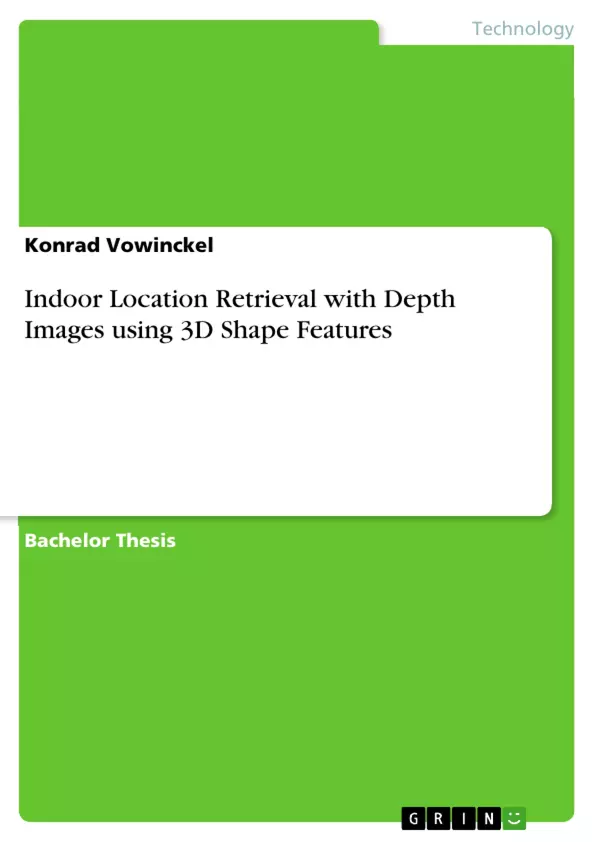Content-based image retrieval (CBIR) for location recognition allows more precise indoor navigation than state-of-the-art methods. Using range images and matching a query image to a dataset of geo-tagged images is current research. This thesis investigates the prospects of applying 3D Shape feature detectors and descriptors to a point cloud projection of the range image. Therefor at first the keypoint detection methods Normal Aligned Radial Feature (NARF), Intrinsic Shape Signatures (ISS) and HARRIS3D detector are described, followed by the shape feature descriptors Spin Images, Signatures of Histograms of Orientations (SHOT) and Unique Shape Context (USC). Special attention is paid to the parameters. Varying radii, border estimation methods, preset filters and computing times are analysed in order to determine, how to set those parameters to obtain good results. The results exhibit the shortcomings of the state-of-the-art 3D feature algorithms, in application of indoor navigation. Finally suggestions for improvement are made.
Inhaltsverzeichnis (Table of Contents)
- Introduction
- Background and Methods
- Image and Location Retrieval
- Database of Range Images
- Feature Extraction
- Matching of Features
- Evaluation of Matching
- Depth Image to Point Cloud Projection
- Keypoints Detection Methods
- NARF Keypoint Detector
- ISS Keypoint Detector
- HARRIS3D Keypoint Detector
- Feature Description Methods
- NARF Feature Descriptor
- Spin Image Feature Descriptor
- SHOT Feature Descriptor
- USC Feature Descriptor
- Implementation
- Overall Design
- Filtering
- Normal Estimation
- Keypoint Detectors
- NARF Implementation
- ISS Implementation
- HARRIS3D Implementation
- NARF and ISS Combination
- Feature Descriptors
- NARF Feature Descriptor Implementation
Zielsetzung und Themenschwerpunkte (Objectives and Key Themes)
This thesis explores the application of 3D Shape features for indoor location recognition using depth images. The research focuses on evaluating the effectiveness of different 3D feature detectors and descriptors in the context of indoor navigation. The main objective is to determine whether these methods can be used to create a reliable and accurate indoor location retrieval system. The key themes explored in this thesis are: * **Content-based Image Retrieval (CBIR) for Indoor Navigation:** This thesis explores the use of CBIR techniques for indoor navigation, aiming to enhance the precision of location recognition compared to traditional methods. * **3D Shape Feature Detectors and Descriptors:** The research focuses on evaluating the performance of different 3D shape feature detectors and descriptors, such as NARF, ISS, HARRIS3D, Spin Images, SHOT, and USC. * **Parameter Optimization for 3D Feature Extraction:** The thesis emphasizes the importance of parameter optimization for 3D feature extraction algorithms, analyzing the impact of different settings on the overall performance. * **Point Cloud Projection from Depth Images:** The thesis investigates the use of point cloud projections from depth images as a basis for 3D feature extraction and matching. * **Evaluation of 3D Feature Algorithms for Indoor Navigation:** The research evaluates the strengths and limitations of state-of-the-art 3D feature algorithms in the context of indoor navigation.Zusammenfassung der Kapitel (Chapter Summaries)
Introduction
This chapter introduces the topic of indoor location recognition using content-based image retrieval (CBIR) and highlights the potential benefits of employing 3D shape features in this domain. It sets the stage for the research presented in the subsequent chapters.Background and Methods
This chapter delves into the background of image and location retrieval, explaining the concepts behind range images and their use in indoor navigation. It provides a detailed overview of the feature extraction process, including keypoint detection methods, feature description techniques, and matching algorithms. The chapter also discusses the conversion of depth images into point clouds, a crucial step in applying 3D feature extraction methods.Implementation
This chapter outlines the implementation details of the proposed approach, covering aspects such as overall design, filtering techniques, normal estimation, keypoint detector implementations, and the implementation of feature descriptors.Schlüsselwörter (Keywords)
This thesis explores content-based image retrieval (CBIR), 3D shape feature detectors and descriptors, indoor navigation, point cloud projection, depth images, range images, keypoint detection, feature description, NARF, ISS, HARRIS3D, Spin Images, SHOT, USC, parameter optimization.- Citation du texte
- Konrad Vowinckel (Auteur), 2014, Indoor Location Retrieval with Depth Images using 3D Shape Features, Munich, GRIN Verlag, https://www.grin.com/document/280435



